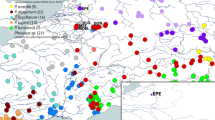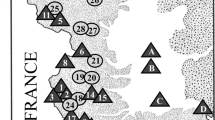Abstract
The number of non-native freshwater fishes in the Iberian Peninsula has been greatly increasing. In this study, individuals of the genus Phoxinus were detected in 18 out of 138 stream sites sampled across the Douro Basin in 2017 and 2018. A total of 26 individuals were barcoded using partial cytochrome c oxidase subunit I (COI) and cytochrome b (cytb) genes for species identification and determination of geographical origin. Molecular data provided the first record of a second Phoxinus species in western Douro (Portugal, Iberian Peninsula), with haplotypes closely matching those found in the Charente River (southern France). This species is suspected to be a recent introduction associated with the use of minnows as live bait by freshwater anglers, which was facilitated by human movements between France and Portugal. Individuals from watercourses in eastern Douro (Spain) were genetically assigned to Phoxinus bigerri, an introduced species previously known for that region, which confirms reports of introduction events from Ebro to Douro Basin probably also related to freshwater angling and facilitated by geographic proximity. The potential ecological impacts of this genus in the region are unknown and need further investigation.





Similar content being viewed by others
References
Anastácio PM, Ribeiro F, Capinha C, Banha F, Gama M, Filipe AF, Rebelo R, Sousa R (2019) Non-native freshwater fauna in Portugal: a review. Sci Total Environ 650:1923–1934
Baganha MIB (1994) As correntes emigratórias portuguesas no século XX e o seu impacto na economia nacional. Análise Soc 29:959–980
Banha F, Diniz A, Anastácio PM (2017) The role of angler’s perceptions and habits in biological invasions: perspectives from the Iberian Peninsula. Aquat Conserv Mar Freshw Ecosyst 27:51–64
Carpenter SR, Stanley EH, Vander Zanden MJ (2011) State of the world’s freshwater ecosystems: physical, chemical, and biological changes. Annu Rev Environ Resour 36:75–99
Clavero M (2011) Assessing the risk of freshwater fish introductions into the Iberian Peninsula. Freshw Biol 56:2145–2155
Clement M, Posada D, Crandall K (2000) TCS: a computer program to estimate gene genealogies. Mol Ecol 9:1657–1660
Corral-Lou A, Perea S, Aparicio E, Doadrio I (2019) Phylogeography and species delineation of the genus Phoxinus Rafinesque, 1820 (Actinopterygii: Leuciscidae) in the Iberian Peninsula. J Zool Syst Evol Res 57:926–941
Doadrio I, Garzón P (1986) Nuevas localidades de Phoxinus phoxinus (L., 1758) (Ostariophysi, Cyprinidae) en la Península Ibérica. Misc Zool 10:389–390
Drummond AJ, Ashton B, Buxton S, Cheung M, Cooper A, Duran C, Field M, Heled J, Kearse M, Markowitz S, Moir R, Stones-Havas S, Sturrock S, Thierer T, Wilson A (2010) GENEIOUS v5.5. http://www.geneious.com
Filipe AF, Filomena Magalhães M, Collares-Pereira MJ (2010) Native and introduced fish species richness in Mediterranean streams: the role of multiple landscape influences. Divers Distrib 16:773–785
Filipe AF, Lawrence JE, Bonada N (2013) Vulnerability of stream biota to climate change in mediterranean climate regions: a synthesis of ecological responses and conservation challenges. Hydrobiologia 719:331–351
Folmer O, Black M, Hoeh W, Lutz R, Vrijenhoek R (1994) DNA primers for amplification of mitochondrial cytochrome c oxidase subunit I from diverse metazoan invertebrates. Mol Mar Biol Biotechnol 3:294–299
INSEE Institut National de la Statistique et des Études Économiques, Recensement de la population 2010. http://www.insee.fr/. Accessed 20 Mar 2019
Johnson M, Zaretskaya I, Raytselis Y, Merezhuk Y, McGinnis S, Madden TL (2008) NCBI BLAST: a better web interface. Nucl Acids Res 36:W5–W9
Kamenova S, Bartley TJ, Bohan DA, Boutain JR, Colautti RI, Domaizon I, Fontaine C, Lemainque A, Le Viol I, Mollot G, Perga ME, Ravign V, Massol F (2017) Chapter three—invasions toolkit: current methods for tracking the spread and impact of invasive species. Adv Ecol Res 56:85–182
Kottelat M (2007) Three new species of Phoxinus from Greece and southern France (Teleostei: Cyprinidae). Ichthyol Explor Fres 18:145–162
Museth J, Hesthagen T, Sandlund OT, Thorstad EB, Ugedal O (2007) The history of the minnow Phoxinus phoxinus (L.) in Norway: from harmless species to pest. J Fish Biol 71:184–195
Palandačić A, Naseka A, Ramler D, Ahnelt H (2017) Contrasting morphology with molecular data: an approach to revision of species complexes based on the example of European Phoxinus (Cyprinidae). BMC Evol Biol 17:184
Palandačić A, Kruckenhauser L, Ahnelt H, Mikschi E (2020) European minnows through time: museum collections aid genetic assessment of species introductions in freshwater fishes (Cyprinidae: Phoxinus species complex). Heredity 124:410–422
Palumbi SR (1996) Nucleic acids II: the Polymerase Chain Reaction. In: Hillis DM, Moritz C, Mable BK (eds) Molecular systematics. Sinaeur Associates, Sunderland, pp 205–248
Perdices A, Doadrio I (2001) The molecular systematics and biogeography of the European cobitids based on mitochondrial DNA sequences. Mol Phylogenet Evol 19:468–478
Price MN, Dehal PS, Arkin AP (2009) FastTree: computing large minimum evolution trees with profiles instead of a distance matrix. Mol Biol Evol 26:1641–1650
Ramler D, Palandačić A, Delmastro GB, Wanzenböck J, Ahnelt H (2016) Morphological divergence of lake and stream Phoxinus of Northern Italy and the Danube basin based on geometric morphometric analysis. Ecol Evol 7:572–584
Ratnasingham S, Hebert PDN (2007) BOLD: the barcode of life data system. Mol Ecol Notes 7:355–364
Ribeiro F, Veríssimo A (2014) Full westward expansion of Rutilus rutilus (Linnaeus, 1758) in the Iberian Peninsula. J Appl Ichthyol 30:540–542
Sánchez-Hernández J, Servia MJ, Vieira-Lanero R, Cobo F (2012) New record of translocated Phoxinus bigerri Kottelat, 2007 from a river basin in the North-West Atlantic coast of the Iberian Peninsula. Bioinvasions Rec 1:37–39
Simberloff D, Martin JL, Genovesi P, Maris V, Wardle DA, Aronson J, Courchamp F, Galil B, García-Berthou E, Pascal M, Pyšek P, Sousa R, Tabacchi E, Vilà M (2013) Impacts of biological invasions: what’s what and the way forward. Trends Ecol Evol 28:58–66
Acknowledgements
We acknowledge Fernando Teixeira, Fernando Miranda, Mário Ferreira, Sara Carona, José Pedro Ramião and Francisco Carvalho for the valuable assistance during fieldwork. We specially thank Maria Filomena Magalhães for previous fruitful discussions and logistic support. We are grateful to Matthias F. Geiger and Andrea Corral Lou for facilitating genetic data and coordinates of sampling sites. Finally, we appreciate the comments of the three anonymous reviewers that improved the quality of the manuscript. AFF and AGR were supported by the project FRESHING founded by the Portuguese Foundation for Science and Technology (FCT) and COMPETE (PTDC/AAGMAA/2261/2014 – POCI-01-0145-FEDER-356016824). FMSM was supported by the FCT PhD grant SFRH/BD/104703/2014. This study was conducted as part of the projects FRESHING and FRESHCO. The latter is also supported by FCT and COMPETE (PTDC/AGR-FOR/1627/2014 – 04/SAICT/2015) and UID/AGR/04033/2019. Logistic support was also facilitated by the ENVMETAGEN – Capacity Building at InBIO for Research and Innovation Using Environmental Metagenomics project at CIBIO laboratories (668981; EUH2020-WIDESPREAD-2014-2).
Author information
Authors and Affiliations
Corresponding authors
Additional information
Publisher's Note
Springer Nature remains neutral with regard to jurisdictional claims in published maps and institutional affiliations.
Electronic supplementary material
Below is the link to the electronic supplementary material.
Rights and permissions
About this article
Cite this article
Garcia-Raventós, A., Martins, F.M.S., Teixeira, A. et al. Origin and history of Phoxinus (Cyprinidae) introductions in the Douro Basin (Iberian Peninsula): an update inferred from genetic data. Biol Invasions 22, 2409–2419 (2020). https://doi.org/10.1007/s10530-020-02279-5
Received:
Accepted:
Published:
Issue Date:
DOI: https://doi.org/10.1007/s10530-020-02279-5




